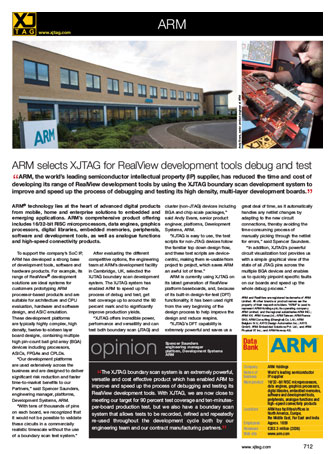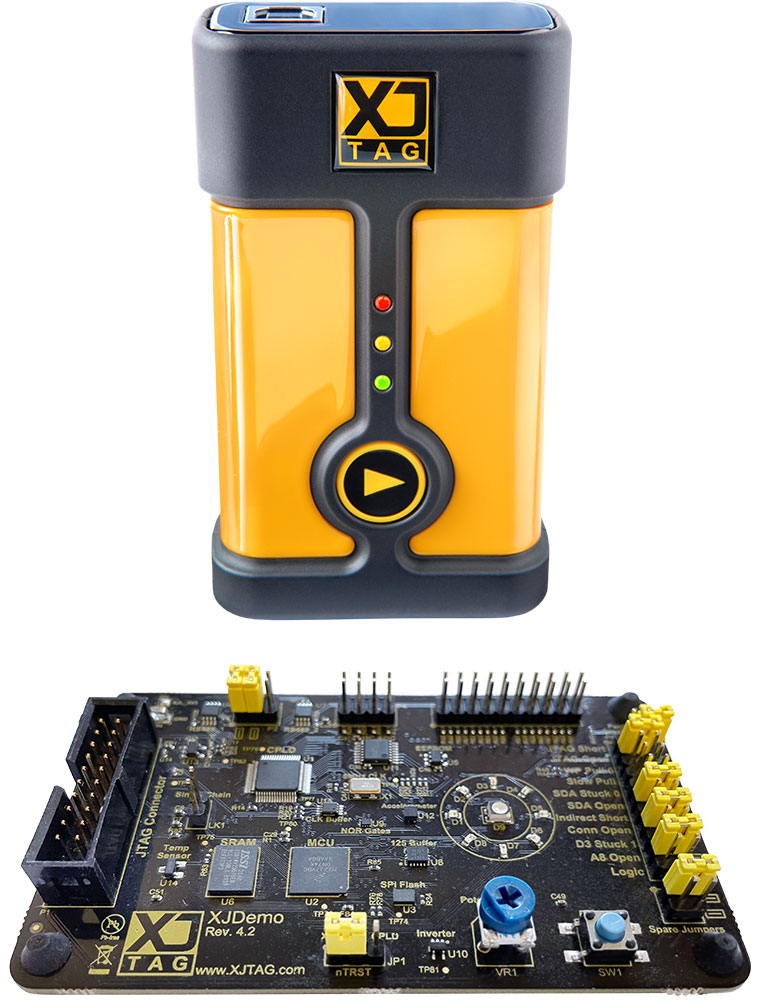
ARM selects XJTAG for RealView development tools debug and test
“ARM, the world’s leading semiconductor intellectual property (IP) supplier, has reduced the time and cost of developing its range of RealView® development tools by using the XJTAG boundary scan development system to improve and speed up the process of debugging and testing its high density, multi-layer development boards.”
ARM® technology lies at the heart of advanced digital products from mobile, home and enterprise solutions to embedded and emerging applications. ARM’s comprehensive product offering includes 16/32-bit RISC microprocessors, data engines, graphics processors, digital libraries, embedded memories, peripherals, software and development tools, as well as analog functions and high-speed connectivity products.
To support the company’s SoC IP, ARM has developed a strong base of development tools, software and hardware products. For example, its range of RealView® development solutions are ideal systems for customers prototyping ARM processor-based products and are suitable for architecture and CPU evaluation, hardware and software design, and ASIC emulation. These development platforms are typically highly complex, high density, twelve-to-sixteen layer board designs, containing multiple high pin-count ball grid array (BGA) devices including processors, ASICs, FPGAs and CPLDs.
“Our development platforms are used extensively across the business and are designed to deliver significant risk reduction and faster time-to-market benefits to our Partners,” said Spencer Saunders, engineering manager, platforms, Development Systems, ARM. “With tens of thousands of pins on each board, we recognized that it would not be possible to validate these circuits in a commercially realistic timescale without the use of a boundary scan test system.”
After evaluating the different competitive options, the engineering team at ARM’s development facility in Cambridge, UK, selected the XJTAG boundary scan development system. The XJTAG system has enabled ARM to speed up the process of debug and test, get test coverage up to around the 90 percent mark and to significantly improve production yields.
“XJTAG offers incredible power, performance and versatility and can test both boundary scan (JTAG) and cluster (non-JTAG) devices including BGA and chip scale packages,” said Andy Evans, senior product engineer, platforms, Development Systems, ARM. “XJTAG is easy to use, the test scripts for non-JTAG devices follow the familiar top down design flow, and these test scripts are device-centric, making them re-usable from project to project, which saves ARM an awful lot of time.”
ARM is currently using XJTAG on its latest generation of RealView platform baseboards, and, because of its built-in design-for-test (DFT) functionality, it has been used right from the very beginning of the design process to help improve the design and reduce respins.
“XJTAG’s DFT capability is extremely powerful and saves us a great deal of time, as it automatically handles any netlist changes by adapting to the new circuit connections, thereby avoiding the time-consuming process of manually picking through the netlist for errors,” said Spencer Saunders. “In addition, XJTAG’s powerful circuit visualization tool provides us with a simple graphical view of the state of all JTAG pins across the multiple BGA devices and enables us to quickly pinpoint specific faults on our boards and speed up the whole debug process.”
ARM and RealView are registered trademarks of ARM Limited. All other brands or product names are the property of their respective holders. “ARM” is used to represent ARM Holdings plc; its operating company ARM Limited; and the regional subsidiaries ARM INC.; ARM KK; ARM Korea Ltd.; ARM Taiwan; ARM France SAS; ARM Consulting (Shanghai) Co. Ltd.; ARM Belgium N.V.; AXYS Design Automation Inc.; AXYS GmbH; ARM Embedded Solutions Pvt. Ltd.; and ARM Physical IP, Inc.; and ARM Norway AS.

The XJTAG boundary scan system is an extremely powerful, versatile and cost effective product which has enabled ARM to improve and speed up the process of debugging and testing its RealView development tools.
With XJTAG, we are now close to meeting our target for 90 percent test coverage and ten-minutes-per-board production test, but we also have a boundary scan system that allows tests to be recorded, refined and repeatedly re-used throughout the development cycle both by our engineering team and our contract manufacturing partners.

Company: ARM Holdings
Nature of business: World’s leading semiconductor IP supplier
Main products:
16/32-bit RISC microprocessors, data engines, graphics processors, digital libraries, embedded memories, software and development tools, peripherals, analogue functions and high-speed connectivity products
Locations: ARM has facilities/offices in North America, Europe, the Middle East, Far East and India
Employees: Approx. 1659
Revenues: £263.3 million (2006)
Web site: www.arm.com

Configure your products













